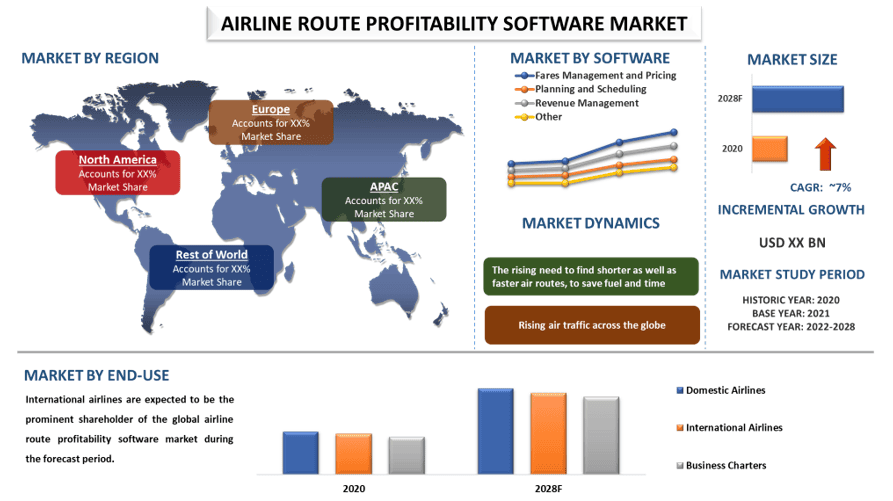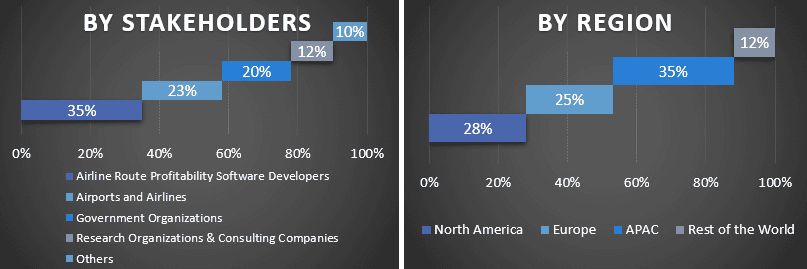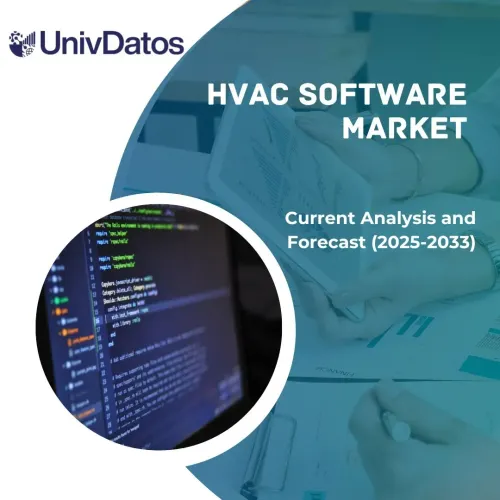- Home
- Chi siamo
- Settore
- Servizi
- Lettura
- Contattaci
Mercato del software di redditività delle rotte aeree: analisi attuale e previsioni (2022-2028)
Focus sul software (Gestione delle tariffe e dei prezzi, Pianificazione e programmazione, Gestione delle entrate e Altro software); Uso finale (Compagnie aeree nazionali, Compagnie aeree internazionali e Charter aziendali); e Regione/Paese

Si prevede che il mercato globale del software per la redditività delle rotte aeree crescerà a un tasso di crescita di circa il 7% durante il periodo di previsione. Il software per la redditività delle rotte aeree aiuta le compagnie aeree ad aumentare i margini di profitto calcolando e valutando il costo delle rotte attualmente operative. La pianificazione del volo è anche una parte importante della redditività delle rotte aeree, il piano di volo contiene la rotta che l'equipaggio percorrerà, indicando l'altitudine e la velocità. Include anche i calcoli di quanto carburante utilizza l'aereo e quanto carburante extra è necessario per soddisfare vari requisiti di sicurezza. Il maggiore utilizzo di tecnologie come l'intelligenza artificiale, il commercio mobile e conversazionale, unitamente all'analisi aziendale e alla market intelligence, viene utilizzato per identificare le tendenze della domanda e aumentare i margini di profitto calcolando e valutando il costo delle rotte attualmente operative. Inoltre, la crescente necessità di trovare rotte aeree più brevi e veloci, per risparmiare carburante e tempo, e l'aumento del traffico aereo in tutto il mondo stanno anche contribuendo alla crescita del mercato. Ad esempio, secondo la Federal Aviation Administration, nel 2021, l'Air Traffic Organization (ATO) ha gestito un totale di 16.405.000 voli.
SITA, International Business Machines Corporation, Amadeus IT Group S.A., Sabre GLBL Inc., Orane Consulting Pvt. Ltd., Damarel Systems International Ltd., Airport Information Systems Limited, Wipro Limited, Laminar Aviation Pte. Ltd. e QlikTech International AB sono alcuni dei principali attori del mercato. Diverse fusioni e acquisizioni insieme a partnership sono state intraprese da questi attori per fornire ai clienti prodotti/tecnologie hi-tech e innovativi.
Approfondimenti presentati nel rapporto
"Tra i software, il segmento della pianificazione e della programmazione dovrebbe registrare un robusto CAGR durante il periodo di previsione"
In base al software, il mercato è classificato in gestione e tariffazione delle tariffe, pianificazione e programmazione, gestione delle entrate e altri software. Tra questi, si prevede che il segmento della pianificazione e della programmazione registrerà un robusto CAGR durante il periodo di previsione a causa della necessità di generare un orario di volo che raggiunga l'uso più efficace delle risorse di una compagnia aerea.
"Tra gli usi finali, il segmento delle compagnie aeree internazionali deterrà una quota significativa del mercato nel 2020"
In base all'uso finale, il mercato è suddiviso in compagnie aeree nazionali, compagnie aeree internazionali e charter aziendali. Si prevede che le compagnie aeree internazionali saranno il principale azionista del mercato globale del software per la redditività delle rotte aeree durante il periodo di previsione. Fattori come la crescente domanda da parte della classe media, la crescita della popolazione e del turismo, i redditi disponibili più elevati, la demografia favorevole, la crescente penetrazione degli aeromobili e la crescita delle infrastrutture aeronautiche stanno contribuendo alla crescita di questo segmento.
"L'Asia-Pacifico deterrà una quota significativa del mercato"
Si prevede che l'Asia-Pacifico crescerà a un tasso di crescita elevato durante il periodo di previsione. La regione è il centro di un'industria aeronautica in rapida crescita, con Cina e India che sono i principali hub aeronautici. La crescita dei paesi turistici come Indonesia, Singapore, Corea del Sud, Malesia, Thailandia e altri sta portando a un aumento del numero di passeggeri nella regione. Per capitalizzare la domanda nella regione, l'industria aeronautica ha effettuato investimenti strategici e prevede di espandere la propria presenza nella regione. L'industria aeronautica utilizza il software per la redditività delle rotte per valutare le rotte esistenti, comprendere i margini di profitto, pianificare e preventivare la redditività delle rotte e consentire l'aggiunta di nuove rotte in futuro.
Motivi per acquistare questo rapporto:
- Lo studio include l'analisi delle dimensioni e delle previsioni del mercato convalidate da esperti chiave autenticati del settore.
- Il rapporto presenta una rapida panoramica delle prestazioni complessive del settore a colpo d'occhio.
- Il rapporto copre un'analisi approfondita dei principali pari del settore con un focus primario sulle principali finanze aziendali, sui portafogli di prodotti, sulle strategie di espansione e sugli sviluppi recenti.
- Esame dettagliato dei driver, dei vincoli, delle tendenze chiave e delle opportunità prevalenti nel settore.
- Lo studio copre in modo esauriente il mercato attraverso diversi segmenti.
- Analisi approfondita a livello regionale del settore.
Opzioni di personalizzazione:
Il mercato globale del software per la redditività delle rotte aeree può essere ulteriormente personalizzato in base alle esigenze o a qualsiasi altro segmento di mercato. Oltre a questo, UMI comprende che potresti avere le tue esigenze aziendali, quindi sentiti libero di metterti in contatto con noi per ottenere un rapporto che si adatti completamente alle tue esigenze.
Indice
Metodologia di ricerca per l'analisi del mercato del software di redditività delle rotte aeree (2022-2028)
L'analisi del mercato storico, la stima del mercato attuale e la previsione del mercato futuro del mercato globale del software di redditività delle rotte aeree sono stati i tre passaggi principali intrapresi per creare e analizzare l'adozione del software di redditività delle rotte aeree nelle principali regioni a livello globale. È stata condotta un'esaustiva ricerca secondaria per raccogliere i dati storici del mercato e stimare le dimensioni del mercato attuale. In secondo luogo, per convalidare queste informazioni, sono stati presi in considerazione numerosi risultati e presupposti. Inoltre, sono state condotte anche interviste primarie esaustive con esperti del settore lungo tutta la catena del valore del mercato globale del software di redditività delle rotte aeree. Dopo l'assunzione e la convalida dei dati di mercato attraverso interviste primarie, abbiamo impiegato un approccio top-down/bottom-up per prevedere le dimensioni complete del mercato. Successivamente, sono stati adottati metodi di suddivisione del mercato e triangolazione dei dati per stimare e analizzare le dimensioni del mercato dei segmenti e sottosegmenti del settore di pertinenza. La metodologia dettagliata è spiegata di seguito:
Analisi delle dimensioni del mercato storico
Passaggio 1: Studio approfondito delle fonti secondarie:
È stato condotto uno studio secondario dettagliato per ottenere le dimensioni storiche del mercato del software di redditività delle rotte aeree attraverso fonti interne aziendali come relazioni annuali e bilanci, presentazioni delle prestazioni, comunicati stampa, ecc., e fonti esterne tra cui riviste, notizie e articoli, pubblicazioni governative, pubblicazioni della concorrenza, relazioni di settore, database di terze parti e altre pubblicazioni credibili.
Passaggio 2: Segmentazione del mercato:
Dopo aver ottenuto le dimensioni storiche del mercato del software di redditività delle rotte aeree, abbiamo condotto un'analisi secondaria dettagliata per raccogliere informazioni storiche sul mercato e condividere per diversi segmenti e sottosegmenti per le principali regioni. I principali segmenti inclusi nel report sono software e uso finale. Ulteriori analisi a livello di paese sono state condotte per valutare l'adozione complessiva dei modelli di test in quella regione.
Passaggio 3: Analisi dei fattori:
Dopo aver acquisito le dimensioni storiche del mercato di diversi segmenti e sottosegmenti, abbiamo condotto un'analisi dei fattori dettagliata per stimare le dimensioni attuali del mercato del software di redditività delle rotte aeree. Inoltre, abbiamo condotto un'analisi dei fattori utilizzando variabili dipendenti e indipendenti come software e uso finale del software di redditività delle rotte aeree. È stata condotta un'analisi approfondita per gli scenari lato domanda e offerta considerando le principali partnership, fusioni e acquisizioni, espansione aziendale e lancio di prodotti nel settore del mercato del software di redditività delle rotte aeree in tutto il mondo.
Stima e previsione delle dimensioni del mercato attuale
Dimensionamento del mercato attuale: Sulla base delle informazioni fruibili dei 3 passaggi precedenti, siamo giunti alle dimensioni attuali del mercato, ai principali attori nel mercato globale del software di redditività delle rotte aeree e alle quote di mercato dei segmenti. Tutte le percentuali di ripartizione richieste e le suddivisioni del mercato sono state determinate utilizzando l'approccio secondario sopra menzionato e sono state verificate attraverso interviste primarie.
Stima e previsione: Per la stima e la previsione del mercato, sono stati assegnati pesi a diversi fattori, inclusi driver e tendenze, vincoli e opportunità disponibili per le parti interessate. Dopo aver analizzato questi fattori, sono state applicate tecniche di previsione pertinenti, ovvero l'approccio top-down/bottom-up, per arrivare alla previsione di mercato per il 2028 per diversi segmenti e sottosegmenti nei principali mercati a livello globale. La metodologia di ricerca adottata per stimare le dimensioni del mercato comprende:
- Le dimensioni del mercato del settore, in termini di entrate (USD) e il tasso di adozione del mercato del software di redditività delle rotte aeree nei principali mercati a livello nazionale
- Tutte le percentuali di ripartizione, suddivisioni e ripartizioni dei segmenti e sottosegmenti di mercato
- Attori chiave nel mercato globale del software di redditività delle rotte aeree in termini di prodotti offerti. Inoltre, le strategie di crescita adottate da questi attori per competere nel mercato in rapida crescita
Convalida delle dimensioni e della quota di mercato
Ricerca primaria: Sono state condotte interviste approfondite con i Key Opinion Leaders (KOL) tra cui dirigenti di alto livello (CXO/VP, responsabile vendite, responsabile marketing, responsabile operativo, responsabile regionale, responsabile nazionale, ecc.) nelle principali regioni. I risultati della ricerca primaria sono stati quindi riassunti ed è stata eseguita un'analisi statistica per dimostrare l'ipotesi dichiarata. Gli input della ricerca primaria sono stati consolidati con i risultati secondari, trasformando così le informazioni in informazioni fruibili.
Ripartizione dei partecipanti primari nelle diverse regioni

Ingegneria del mercato
La tecnica di triangolazione dei dati è stata impiegata per completare la stima complessiva del mercato e per arrivare a numeri statistici precisi per ciascun segmento e sottosegmento del mercato globale del software di redditività delle rotte aeree. i dati sono stati suddivisi in diversi segmenti e sottosegmenti dopo aver studiato vari parametri e tendenze nelle aree del software e dell'uso finale nel mercato globale del software di redditività delle rotte aeree.
L'obiettivo principale dello studio sul mercato globale del software di redditività delle rotte aeree
Le tendenze di mercato attuali e future del mercato globale del software di redditività delle rotte aeree sono state individuate nello studio. Gli investitori possono ottenere informazioni strategiche per basare la loro discrezione per gli investimenti sull'analisi qualitativa e quantitativa eseguita nello studio. Le tendenze di mercato attuali e future hanno determinato l'attrattiva complessiva del mercato a livello regionale, fornendo una piattaforma per il partecipante industriale per sfruttare il mercato non sfruttato a vantaggio di un vantaggio di first-mover. Altri obiettivi quantitativi degli studi includono:
- Analizzare le dimensioni del mercato attuale e previsto del mercato del software di redditività delle rotte aeree in termini di valore (USD). Inoltre, analizzare le dimensioni del mercato attuale e previsto di diversi segmenti e sottosegmenti
- I segmenti nello studio includono le aree del software e dell'uso finale
- Definire e analizzare il quadro normativo per l'industria del software di redditività delle rotte aeree
- Analizzare la catena del valore coinvolta con la presenza di vari intermediari, insieme all'analisi dei comportamenti dei clienti e dei concorrenti del settore
- Analizzare le dimensioni del mercato attuale e previsto del mercato del software di redditività delle rotte aeree per la regione principale
- I principali paesi delle regioni studiati nel report includono Asia Pacifico, Europa, Nord America e Resto del mondo
- Profili aziendali del mercato del software di redditività delle rotte aeree e le strategie di crescita adottate dagli operatori di mercato per sostenere il mercato in rapida crescita
- Analisi approfondita a livello regionale del settore
Correlati Report
I clienti che hanno acquistato questo articolo hanno acquistato anche










